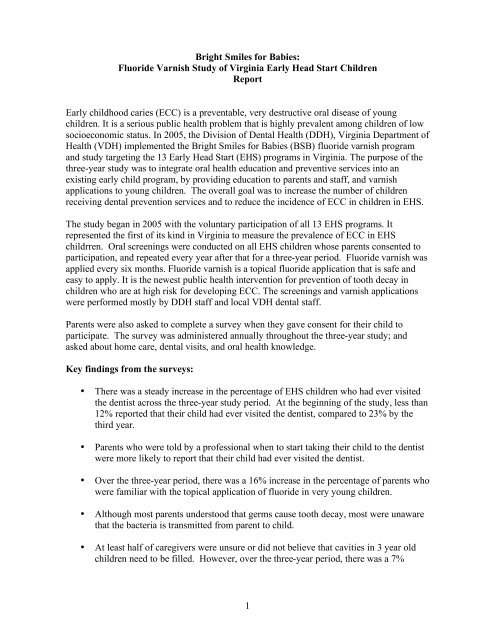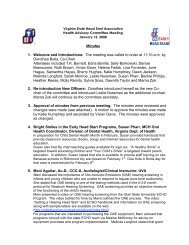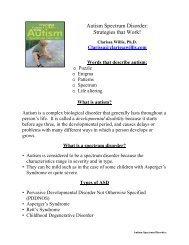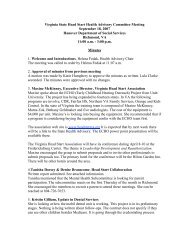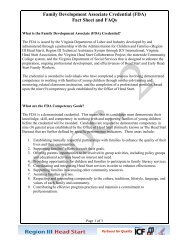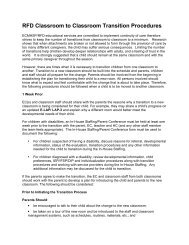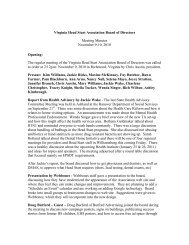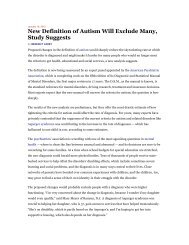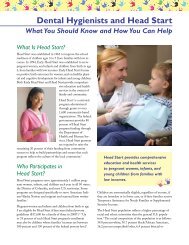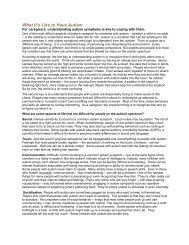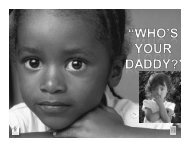Bright Smiles for Babies - Virginia Head Start Association
Bright Smiles for Babies - Virginia Head Start Association
Bright Smiles for Babies - Virginia Head Start Association
Create successful ePaper yourself
Turn your PDF publications into a flip-book with our unique Google optimized e-Paper software.
<strong>Bright</strong> <strong>Smiles</strong> <strong>for</strong> <strong>Babies</strong>:<br />
Fluoride Varnish Study of <strong>Virginia</strong> Early <strong>Head</strong> <strong>Start</strong> Children<br />
Report<br />
Early childhood caries (ECC) is a preventable, very destructive oral disease of young<br />
children. It is a serious public health problem that is highly prevalent among children of low<br />
socioeconomic status. In 2005, the Division of Dental Health (DDH), <strong>Virginia</strong> Department of<br />
Health (VDH) implemented the <strong>Bright</strong> <strong>Smiles</strong> <strong>for</strong> <strong>Babies</strong> (BSB) fluoride varnish program<br />
and study targeting the 13 Early <strong>Head</strong> <strong>Start</strong> (EHS) programs in <strong>Virginia</strong>. The purpose of the<br />
three-year study was to integrate oral health education and preventive services into an<br />
existing early child program, by providing education to parents and staff, and varnish<br />
applications to young children. The overall goal was to increase the number of children<br />
receiving dental prevention services and to reduce the incidence of ECC in children in EHS.<br />
The study began in 2005 with the voluntary participation of all 13 EHS programs. It<br />
represented the first of its kind in <strong>Virginia</strong> to measure the prevalence of ECC in EHS<br />
childrren. Oral screenings were conducted on all EHS children whose parents consented to<br />
participation, and repeated every year after that <strong>for</strong> a three-year period. Fluoride varnish was<br />
applied every six months. Fluoride varnish is a topical fluoride application that is safe and<br />
easy to apply. It is the newest public health intervention <strong>for</strong> prevention of tooth decay in<br />
children who are at high risk <strong>for</strong> developing ECC. The screenings and varnish applications<br />
were per<strong>for</strong>med mostly by DDH staff and local VDH dental staff.<br />
Parents were also asked to complete a survey when they gave consent <strong>for</strong> their child to<br />
participate. The survey was administered annually throughout the three-year study; and<br />
asked about home care, dental visits, and oral health knowledge.<br />
Key findings from the surveys:<br />
• There was a steady increase in the percentage of EHS children who had ever visited<br />
the dentist across the three-year study period. At the beginning of the study, less than<br />
12% reported that their child had ever visited the dentist, compared to 23% by the<br />
third year.<br />
• Parents who were told by a professional when to start taking their child to the dentist<br />
were more likely to report that their child had ever visited the dentist.<br />
• Over the three-year period, there was a 16% increase in the percentage of parents who<br />
were familiar with the topical application of fluoride in very young children.<br />
• Although most parents understood that germs cause tooth decay, most were unaware<br />
that the bacteria is transmitted from parent to child.<br />
• At least half of caregivers were unsure or did not believe that cavities in 3 year old<br />
children need to be filled. However, over the three-year period, there was a 7%<br />
1
increase in parents who agreed that cavities in the teeth of 3 year olds need to be<br />
filled.<br />
• Most of the surveyed parents indicated that children should start going to the dentist<br />
at 1 – 3 years of age, increasing from 83% to 88% over the the three year period.<br />
• The percentage of children with untreated decay declined each year primarily on<br />
smooth tooth surfaces.<br />
Discussion:<br />
The findings of this study were encouraging <strong>for</strong> several reasons. Integration of oral<br />
health services into Early <strong>Head</strong> <strong>Start</strong> programs appears to have contributed to an<br />
improvement in parental oral health knowledge and behavior. Over the three-year period,<br />
parents became more knowledgable about topical fluoride applications <strong>for</strong> young children,<br />
the infectious nature of ECC, and the importance of early dental visits and restoring baby<br />
teeth. The program also resulted in a reduction in untreated tooth decay over a three-year<br />
period. The data suggest that fluoride varnish was instrumental in reducing untreated decay<br />
on smooth surfaces.<br />
Delivering the varnish services and education programs presented challenges and<br />
successes. The average annual participation rate <strong>for</strong> the varnish program was approximately<br />
30%. The rates were lower <strong>for</strong> those programs with larger numbers of home-based enrollees,<br />
who often have transportation problems. Developing local community partners to provide<br />
the services was successful in most of the programs. With the exception of one program, that<br />
partnered with a community health center dentist, all localities were able to utilize their local<br />
VDH public health dental staff.<br />
Oral health education programs were offered to parents either in a group setting or<br />
individually during the actual varnish event. Eight EHS programs held group parent trainings<br />
The group events were offered during parent meetings, and attendance was typically very<br />
low. However, when the parent was present at the varnish event, the parent received one-onone<br />
oral health in<strong>for</strong>mation that was specific to the child and parent.<br />
Currently, eleven programs have community providers committed to help sustain the<br />
prevention program. Among the two programs without a sustainable plan, one failed to<br />
maintain communication with DDH. The other program was encouraged by the local VDH<br />
health department to bring the children into the local dental clinic <strong>for</strong> varnish applications,<br />
rather than have on-site applications.<br />
Recommendations:<br />
The <strong>Virginia</strong> Department of Health recommends the continuation of the BSB<br />
program through EHS. Fluoride varnish is proven to be effective in decreasing tooth decay.<br />
Providing services through EHS programs improves access to care <strong>for</strong> children in high need<br />
of preventive services. VDH plans to provide continued support <strong>for</strong> the program.<br />
2
In<strong>for</strong>mational packets have been developed and were given to EHS program contacts in<br />
September 2008. In order to maintain the semi-annual varnish applications, the EHS staff<br />
person will be responsible <strong>for</strong> initiating contact with the dental provider who will be<br />
providing the screenings and varnishes Continuing to provide educational opportunities to<br />
parents regarding the importance of healthy primary teeth in their young children is an<br />
important prevention service. Parent education can be provided by trained EHS staff or by<br />
local dental providers. Resources are available through the DDH <strong>for</strong> providing parent<br />
education seminars. DDH encourages and will provide staff training upon request to ensure<br />
that EHS staff have the most up-to-date oral health in<strong>for</strong>mation.<br />
Note: The full report is available upon request: Susan.Pharr@vdh.virginia.gov<br />
7/27/2009<br />
3


